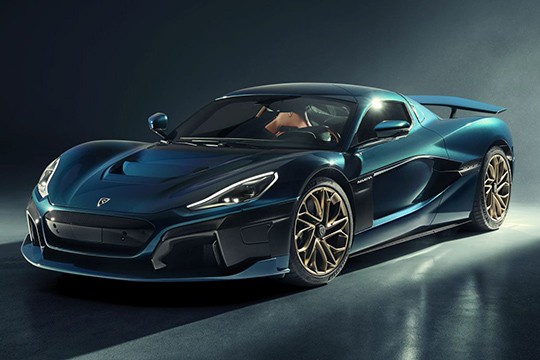Body style: Coupé (two-door)
Segment: Coupe
Production years: 2021, 2022, 2023, 2024
 30 Photos
30 PhotosRimac Nevera was the fastest accelerating hypercar globally when it was introduced in 2020, and the production was limited to 150 units.
When Mate Rimac started his company in a garage in Croatia in 2009, he didn't know that he would become the manufacturer of the fastest production car in the world.
Rimac created the Nevera following the same design language as other hypercars like it was supposed to have an internal combustion engine. But the Croatian carmaker had to do it like that so its customers would recognize the shape of a high-performance vehicle. Its narrow front end and vents on the lower bumper left the impression that it needed those to cool the engine. Instead, it was built to enhance aerodynamics and cool the battery pack. The raked, curved windshield and the sloped roofline followed the same aerodynamic principles of any other supercar on the market at that time. A particular addition was the "cravat" (necktie) design trim placed in front of the rear wheels that sported the colors of the country where the vehicle was sold.
The cabin was handcrafted using the highest quality materials available. Everything was developed in-house, and that led to an exclusive interior. The seats were divided by a wide and tall center console that hosted part of the battery pack. Even the infotainment system placed at the bottom of the center stack was also built by the Croatian company. Its monitor was accompanied by a secondary touch-screen installed in front of the side passenger. At the same time, the driver used a TFT display inside the instrument cluster.
Power went in all corners thanks to a four-motor layout and produced a total of 1,914 PS (1,888 hp), paired to a two-speed automatic gearbox, which enabled the hypercar to exceed the performances of a Bugatti Veyron.
RIMAC Nevera 2021, 2022, 2023, 2024
- 120 KWh (1888 HP)
RIMAC Nevera
120 KWh (1888 HP)
ENGINE SPECS - 120 KWh (1888 HP) | |
|---|---|
| Total maximum power: | 1388.6 kw (1888 hp) |
| Total maximum torque: | 1740.6 lb-ft (2360 Nm) |
| Fuel System: | Electric |
| Fuel: | Electric |
PERFORMANCE SPECS | |
|---|---|
| Top speed (electrical): | 256 mph (412 km/h) |
| Acceleration 0-62 Mph (0-100 kph): | 1.97 s |
TRANSMISSION SPECS | |
|---|---|
| Drive Type: | All Wheel Drive |
| Gearbox: | 2-Speed automatic |
BRAKES SPECS | |
|---|---|
| Front: | Ventilated Discs |
| Rear: | Ventilated discs |
TIRES SPECS | |
|---|---|
| Tire Size: | 275/35 R20 // 315/35 R20 |
DIMENSIONS | |
|---|---|
| Length: | 187 in (4750 mm) |
| Width: | 78.2 in (1986 mm) |
| Height: | 47.6 in (1209 mm) |
| Wheelbase: | 108.1 in (2746 mm) |
| Aerodynamics (Cd): | 0.3 |
WEIGHT SPECS | |
|---|---|
| Unladen Weight: | 4740 lbs (2150 kg) |
POWER SYSTEM SPECS | |
|---|---|
| Power pack: | Lithium Manganese Nickel |
| Nominal Capacity: | 120 kWh |
| Range: | 341.8 miles (550.1 km) |
| Notes |
|---|
| Recuperation output: 300 KW Front electric motors power (2): 229 HP each Front electric motors torque (2): 280 Nm each Rear electric motors power (2): 653 HP each Rear electric motors torque (2): 900 Nm each Front gearbox: Two single speed gearboxes (two independent gearboxes - one at each outer end of the axle) Rear gearbox: Double single speed gearbox (two gearboxes in one housing between the motors) Fast charge 500 kW DC Combo (19 min 0-80% SOC) 350 kW DC Combo (25 min 0-80% SOC) 250 kW DC Combo (30 min 0-80% SOC) On-board charging: 3-phase 22 kW |





























